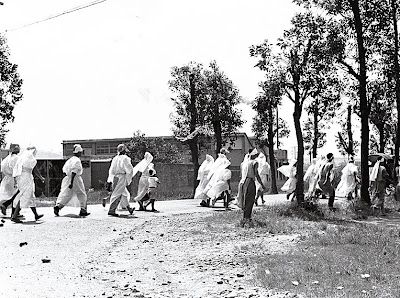He says:
This is a funeral march and it stopped all traffic on Highway One, which I doubt it would do today. Of course in those days Highway One was not much more than a country road.Sarj, when I was growing up in Ohio (as much as I ever actually grew up anyway), traffic always stopped for funeral processions, even oncoming traffic. I doubt if that happens much of anywhere today.
Perhaps someone can explain the flags, robes and other symbols for us.





5 comments:
Here's some of my questions on the phtos. In the second photo could that be the body they are carrying with the decorative flag over it? In the third photo you can see the tail fin of my '57 Chey and there is one man carrying two axe / hoe type tools. Is he going to dig the grave? I have other photos of people working in the fields and they are using this same tool.
Today at work my friend David Ku came by to see me and I asked him about the funeral pictures. He said that yes that was the coffin that they were carrying. The man with the tools was hired by the family to help as well as any other person in normal dress. All the family members dressed in the white cloth which is made of burlap.
Oh I forgot to add, the wreath has the person's name on it.
Hi, Sarj, This kind of traditional funeral parade should be still seen in remote countryside in Taiwan today, but very doubt is in city or even in towns with population over 200,000.
As I was born in 1951 and was raised up in a small town, Ching Shui, in Taichung county, I have taken part in this kind of funeral several times in my life. Below are facts I have learned from my parents or relatives.
The first photo shows all the family members and relatives of the deceased. The ones with hood covering from head to the back are daughters, daughter-in-laws or nieces. Those of male families wearing white robes are sons, son-in-laws, or nephew. Those not wearing white clothes around their bodies are grand children.
Second photo shows the team of grave workers carrying the coffin. An heavily embroidered cloth covering the coffin is for decorative purpose and also represents a heavenly blessing. They are paid workers. The few walking freely alongside the coffin are normally volunteers from the neighbors to help with traffic safety when passing an intersection.
The third shows the grave worker carry the grave tools to be needed in getting the coffin buried in the tomb pit.
The forth shows a wreath which is presented to the deceased by his/her friend, usually with high social status. Following the wreath is a worker carrying a triangular flag on his shoulder. This is the forerunner of the wind band. The triangular flag is just for the purpose of promoting the service of their band.
Morris Chen
Thanks Morris for explaining some of the customs. I too these photos in Nov. 1962 down island on my way to Kaoshung for my honeymoon.
We stayed at a hotel on Love River.
Post a Comment